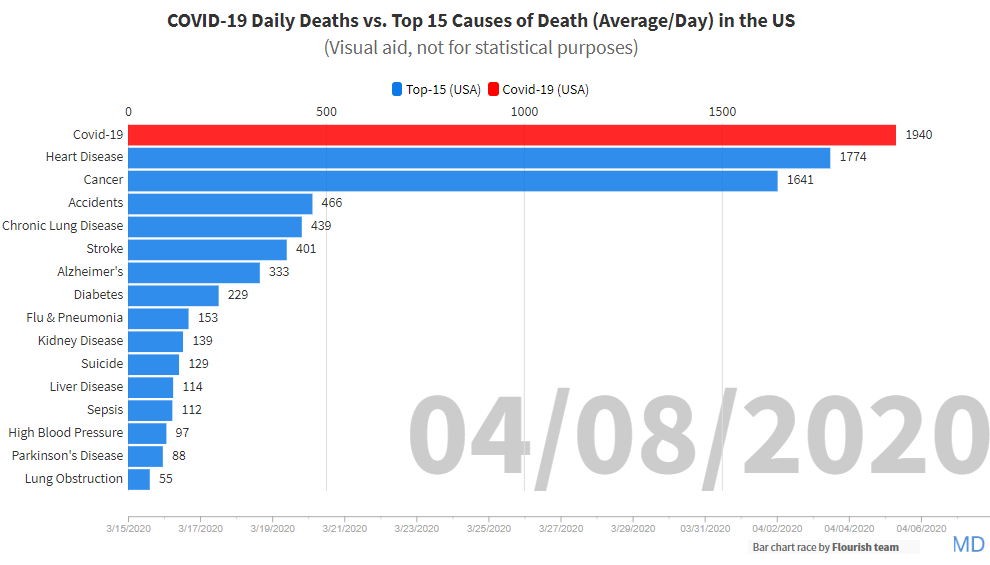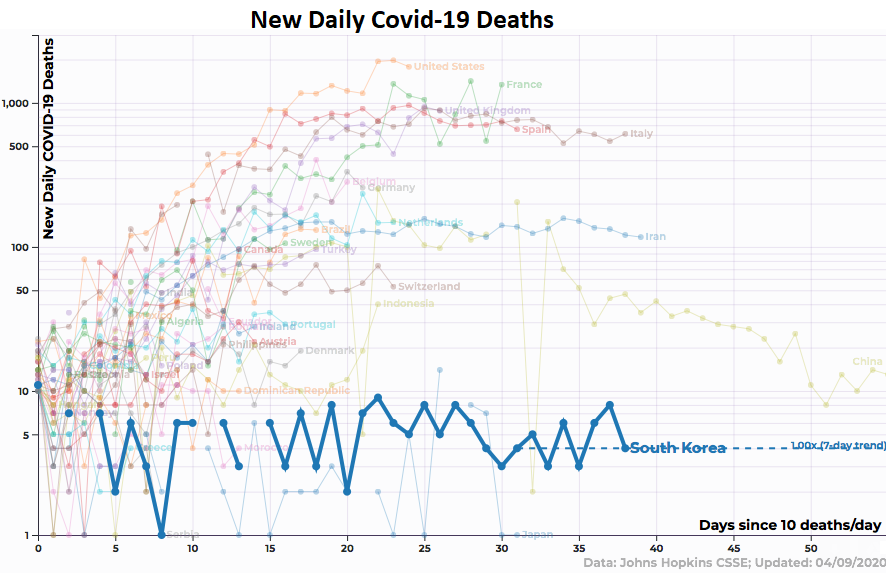What’s an Acceptable Risk Level? ALARA (“As Low As Reasonably Achievable”) to the rescue?
By Wisdom Seeker, a WOLF STREET Commenter with a physical sciences Ph.D., San Francisco Bay Area:
In this essay I’m going to outline how we can balance between stopping COVID and saving the economy. As I wrote last week, we’ve been bending the curve, but now what? Shelter-in-Place orders have slowed the exponential growth of the virus, buying us time and hope.
But as of April 6, COVID-19 became the leading cause of death in the United States, as shown in the graphic below. That cannot continue.
The graphic was developed by Dr. Maria Danilychev, M.D. with the Flourish team, based on CDC data of deaths in 2018 (latest available), average per day, and Covid-19 deaths in the US for the date of the chart, reported on WORLDOMETER.
The picture is particularly grim for New York State, where mortality data from 2017 is now available. In 2017, 425 people per day died in New York State from all causes. The data for 2020 will be similar except for COVID. But this week, COVID-19 in New York State has killed 600-800 people per day, all by itself. So COVID isn’t just the leading cause of death in New York, it’s killing more people than all other causes combined.
Fortunately, thanks to Shelter-in-Place and other measures, COVID shouldn’t reach the 2017 mortality level for New York State: 155,191 for the year. (Math Note: taking 155,191 / 365 is how I got 425 per day.)
The US economy is in shambles. Nearly 17 million initial unemployment claims were filed over the past 3 weeks, and the claims data has yet to catch up with the actual layoffs and furloughs. And the virus is still infecting tens of thousands of people each day, spreading all over the nation and the world. There’s no cure yet, no vaccine, and no significant immunity among the population. To bring back jobs and revive the economy, we can’t sit back and wait until the virus runs its course — we have to get more serious about destroying the virus.
COVID, meet ALARA.
A risk-reduction concept developed originally for radiation protection, ALARA stands for “As Low As Reasonably Achievable.” It’s a systematic application of common sense, the idea that wherever you can’t eliminate a risk, you should take all reasonable steps to reduce the risk to an acceptable level. ALARA can be applied to COVID too. To find the “COVID New Normal,” individuals and organizations all over the world are using this principle to reprogram daily routines and business models – whether they know it or not.
Three tools in the ALARA toolbox are relevant to fighting a pandemic virus: Time, Distance, and Shielding. Minimize exposure time, maximize distance from sources of exposure, and use shielding to block exposure. Shielding includes personal protective equipment (PPE), which is a last line of defense. The best defenses focus on minimizing the source.
Spreading is a 4-stage process:
1) The coronavirus multiplies inside human and animal hosts – who may not have symptoms and may not know they’re infected.
2) Infected hosts “shed” the virus via respiration (breathing, talking, coughing, sneezing), touching objects with contaminated hands, bleeding, and likely also fecal excretion.
3) Outside of hosts, the virus floats briefly in the air, settles or transfers to surfaces, and then slowly breaks down. The virus survives a few minutes under UV light or high temperatures (~70C) a few hours in the air, and 1-7 days on surfaces. Less on cardboard and copper, more on steel and smooth plastics.
4) The virus can infect a new host through the mouth, nose or eyes – via micro-droplets in the air and contaminated hands.
ALARA suggests ways to attack the virus at each stage:
1) Assume every potential host is infected (including ourselves!), and act accordingly.
2) Shielding: Reduce viral shedding into the environment by using masks or any face covering possible on every potential host, including ourselves, at least when outside the home.
3) Distance: Physical, not social distance, is what matters. You can interact remotely with friends. But shun their bodies, the air they’ve breathed, anything that air has touched!
4) Shielding: set up barriers between your safe spaces (work, office) and any potential sources of infection. Beware of shared airflows!
5) Time: minimize time in stores or any other environment where the virus may be present.
6) Many simple acts destroy potential viruses: sunshine (UV light), “grocery quarantine” (use time to disinfect non-perishable goods, mail, and any packages you need to handle), “active disinfection” (use soapy water or other disinfectants to clean non-perishable groceries or other items you might need to handle outside the home).
Reviving the Economy: What’s an Acceptable Risk Level?
In the original radiation-protection context, ALARA is used to bring risks well below an acceptable level, the natural background radiation level. Humanity evolved in, and lives in, a world with background radiation from cosmic rays, radon gas from trace amounts of uranium decaying in the soil, and even radioactive potassium in bananas.
Our cells have DNA repair mechanisms to protect against radiation. Because of that, we can allow activities that involve some radiation exposure, as long as it’s much smaller than those natural levels. An obvious one is medical or dental X-rays. Flying in airplanes is a source of radiation exposure too – less atmosphere, more cosmic rays.
There’s also a natural background level for mortality risks. The graph above shows “Flu & Pneumonia” averaging 153 deaths per day. CDC data says overall mortality in the US was 7708 deaths per day in 2017.
So what’s the acceptable risk in a pandemic-virus context? Your boss may feel any risk to you is okay, as long as his profits are protected. Bankers in hard-hit New York have been forced to go back to work, apparently “because market liquidity.” I find that offensive. It’s already selfish to force others to take excess infection risks, but doubly so when 10% of the workforce is in forced unemployment to reduce those risks.
And the medical workers I know aren’t putting their lives on the line, often without adequate gear, to treat bankers with death-wishes, or other workers imperiled by risk-ignorant bosses. We need a national consensus on this, not every boss for himself.
As I wrote last week, if we can’t put out the fire yet, we have to do a “controlled burn.” But commenters noted that we need a “slow burn” to keep the health care system from being slowly ground to pieces. COVID has destroyed some nursing homes; we can’t let it destroy our last-line-of-defense hospitals. So our current level, 2000/day, is certainly too much.
Humanity has already grudgingly accepted the risk level posed by the flu, so that makes a useful benchmark. And we could consider overall mortality as well. The risk from flu is 150 deaths/day, and 5% of overall annual mortality would be 400/day. Could the U.S. get comfortable with 100-400 COVID deaths per day – nationwide – if we knew it wouldn’t get any worse?
Follow Korea and Wring Out the Risks
To get down to “it’s just the flu” levels, we have to cut the death rate by 5-20x from the current level of 2000/day. To do that and bring back the economy, we have to wring out the infection risks everywhere.
The graph below shows that South Korea, with about 1/7 the US population, is averaging 5 COVID deaths per day for the past 10 days. (Data from Johns Hopkins, graphed using 91-DIVOC.com) In the US that would be 35 deaths/day – certainly acceptable.
But Korea is also doing work-from-home, online school, and no large social gatherings: They’re not back to normal. So the US needs Korean-style test-and-trace and universal use of face masks. But to bring back school, daycare, and full employment, both countries need more, a lot more. In the chart, the US is the very top orange line:
I think we need to rethink how we do everything. So far, we’ve kinda figured out grocery shopping, remote medical care for routine issues, and working and exercising at home wherever possible. But schooling and daycare is a huge challenge. And we have a lot more to do before restaurants, theaters, and sports arenas can reopen as anything other than “super-spread event centers.”
Our “essential businesses” can be better-organized to reduce infection risks. Being an essential worker shouldn’t mean risking your life every day. Less essential businesses must use the “pause time” to figure out how to reduce their own risks, so they can reopen without spiking the death rates.
It will be a while yet before COVID deaths in the US drop to acceptable levels. In the new economy, some companies will be old businesses, reworked with ALARA. And unfortunately, some activities should still be banned until we get a better handle on the virus, including through effective treatments and vaccines. And there will be many other new or expanding businesses, using ALARA to exploit opportunities created by COVID. By Wisdom Seeker, for WOLF STREET.

